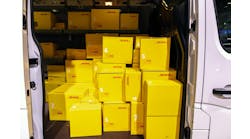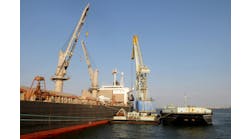The State of US Logistics 2022: Logistics Are “Out of Sync”
Following a year and a half of roller coaster disruption in the supply chain and the prospect of even more ahead, how logisticians can best respond can be best summed up by a single word: agility.
That is the main conclusion to be drawn from the 33rd annual State of Logistics report produced by Council of Supply Chain Management Professionals (CSCMP), with research provided by consulting firm Kearney and sponsored by Penske Logistics, according to Balika Sonthalia, lead author of the report and a partner with Kearney.
“It’s not surprising that we are continuing to see ongoing disruptions related to the pandemic, but the scope and impact of disruptions continue to weigh heavily on the minds of logistics providers—as they do for all companies contributing to the U.S. economy,” she says. Non-pandemic causes also have included port congestion, a truck driver shortage and railroad service deterioration in the face of earlier severe cost-cutting.
The research was conducted before the most recent events impacting supply chain management, including persistently high inflation, the stock market slide and the looming threat of an economic recession—all of which represent quite a change over the previous year. However, given that the problems logisticians faced in 2021 haven’t gone away, most of the report’s recommendations are likely to remain just as apt regardless of what happens next.
“In short, the logistics sector must simultaneously contend with the hangover of red-hot demand and worries of a revenue-diminishing and inventory-swelling downturn,” the researchers said in the report. Needless to say, this is not something that is easy to do.
“With supply chain making up the clear majority of most company’s operations and that of its workforce, it has the greatest potential to make a real impact on its competitive advantage,” offers Mark Baxa, president of CSCMP. “Competing in today’s global marketplace is not just about the high-quality products that supply chains plan, procure, make and deliver. It’s also about impacting the global community and doing vital work like making and delivering life-saving vaccines.”
This year’s report concluded that the total United States business logistics costs in 2021 skyrocketed by 22.4% to $1.85 trillion, representing 8% of 2021’s $23 trillion U.S. GDP. Inventory-carrying costs rose by 25.9% last year, and transportation costs jumped 21.7%—including ocean by 26.3%, road by 23.4% and for parcel carrier services at least 15.2%.
Kearney’s Sonthalia notes that “this is not the first time we’ve seen logistics go through a cycle where inventory levels drop low and logistics assets are scarce, sending costs high, then the industry ramps up and gains capacity and efficiencies, pushing costs down again.”
She adds, “The logistics sector has begun to enable changes which should benefit manufacturers, retailers and consumers alike. We’re especially heartened by the progress the sector has made in rebuilding supply chain resilience via multi-shoring, automation and optionality in last-mile distribution.”
3PLs to the Rescue
Some of the biggest help in dealing with these cost pressures has come from the third-party logistics (3PL) sector that was ready, willing and well positioned to deploy its hard-fought knowledge and high-tech resources to help shippers overcome some of the barriers that were strewn in their way by the pandemic, the supply chain crisis and economic turmoil.
“In fact, a window of opportunity has opened for 3PLs to become more full-fledged consultative partners to shippers, where in the past they were often viewed as interchangeable commodity-service providers,” the Kearney researchers said in the report.
This prospect that they will be able to solidify their commanding role is undergirded by the fact that that 3PLs did very well in 2021, earning both robust revenues and profits from helping customers make their way through the turmoil they faced. According to the SOL report, this turned out to be especially true for those big players who proved themselves capable of investing in additional capacity and automation, and of more fully exploiting information technology by offering integrated solutions built around data insights. Identified as being the top 10 3PLs in terms of warehouse space are industry giants such as DHL Supply Chain, XPO Logistics, Ryder SCS, NFI, Geodis, FedEx Logistics, Kenco Logistics, Penske Logistics, Saddle Creek Logistics and CJ Logistics.
Exploitation of the full capabilities of technology must involve a shared commitment by customers who collaborate with their 3PL service providers, Josh Garrison, head of Cisco Logistics strategy, sourcing & digital transformation, told the Kearney researchers.
“Harnessing the value of quality data, leveraging data-driven insights, and executing across the supply chain with digital precision are required to succeed in today’s world and to truly leverage your supply chain as a competitive differentiator,” he said. “The journey down this path must be a shared journey between customer and logistics partner. Investment and strategic alignment on a digital road map is an imperative to drive a truly successful relationship.”
Since logistics management services were introduced from Europe in the 1980s, almost every service provider in the transportation industry has assumed its mantle, including third parties like freight brokers, intermodal marketing companies, international freight forwarders and customs brokers, as well as transportation providers like trucking companies and parcel delivery carriers.
But it was the warehouse-based 3PLs who found themselves in a particularly good position in 2021, and those who were the most successful also controlled extensive warehouse capabilities, as well as the experience and tools to manage transportation services.
“Business inventories dropped to near historic lows, but the costs to store, handle and finance them spiked,” the researchers point out. At the same time, inventory carrying costs rose by 25.9% and transportation costs—driven by all modes and nodes—were up 21.7%.
However, anyone who is hoping for demand relief in 2022 might end up finding they get a little too much of it soon if the threatened recession develops. “In short, the logistics sector must simultaneously contend with the hangover of red-hot demand and worries of a revenue-diminishing and inventory-swelling downturn,” the researchers said.
When it comes to warehousing, supply chain changes have imposed a new set of demands, transforming the industry. “In an era of increased vendor lead times, uncertain supply and sharply rising customer expectations, shippers have been motivated to rethink lean operations and keep more inventory on hand,” the researchers observed, which will lead to a further reduction in warehouse space availability and the imposition of higher costs.
Net absorption of new warehouse space rose 48%, while the vacancy rate fell from 5.1% in 2020 to just 3.7% last year. Warehouse rents rose by 9.5% in 2021, which was nearly twice as fast as in 2020. Warehouse square footage that was under construction in 2021grew by 54% year-over-year.
“Much of this surge in warehousing demand stemmed from companies competing to cater to customers’ lofty expectations for choice and speed,” the researchers claim.
SKU proliferation (especially in regard to consumer product goods) is already returning to pre-Covid levels, which increases the pressure on warehousing. More than 60% of shoppers now expect deliveries within 48 hours, requiring companies and logistics providers to expand and reimagine their warehousing and distribution center (DC) footprints. These pressures will only increase, with a 10% compound annual growth rate (CAGR) projected for omnichannel commerce over the next five years.
Labor Cost Pressures
Why not simply build more warehouses, even faster? A big reason is in the dearth of available labor to both build and to staff these facilities. The researchers observe that Amazon has driven up front-line warehouse employee wages by offering signing bonuses of up to $3,000. The average front-line warehouse employee at Amazon is now paid $15 per hour, which is slightly above the national average of around $13 per hour.
In Southern California, the Bay Area and Seattle—where shippers, carriers and 3PLs are all competing for scarce labor—wages are up to $19 per hour, nearly 50% above the national average, the report says. Adding to the mounting costs are the trends moving toward greater reliance on omnichannel DCs, flexible warehouse operations and increased automation which require labor reskilling—adding another layer to ongoing expenses.
“Contract logistics providers find themselves at a crossroads,” the researchers stress. “Should they focus their investments on additional capacity, or wager instead on optimizing the performance of available space via technology and other new capabilities? They can’t do it all. A proverbial pot of gold is now enticingly within reach. 3PLs can break free from the historical perception of contract logistics as a commoditized service and raise margins to unprecedented heights by focusing on high-touch, value-add services.”
The researchers also remind 3PLs that shippers will not entrust such a wide range of responsibilities to just anyone. Instead, they will seek out those 3PLs that possess a partnership mindset and the real capabilities that are required to provide customized solutions.
The 3PLs who can persuade shippers to share their data and move to a managed transportation model can then use that access to achieve network economics, building a deep moat that those 3PLs who are unable to invest in capacity and offer efficient operations to offer integrated solutions will find difficult to overcome, the researchers argue.
So much for advice to 3PLs about how they should react in this changed environment. The Kearney consultants also offered some pointed advice for the customers of warehouse-based 3PLs as well. “Companies that long viewed warehousing as a sleepy backwater need to recognize it is now an essential strategic competency,” the researchers stated. “Warehousing is more vital to supply chain strategy than ever before.”
The researchers’ guidelines for how customers can maximize these 3PL provider resources are:
Integrate with planning and transportation. The future warehousing footprint should be shaped through seamless collaboration with commercial strategy and operations planning. Now is a good time to rigorously assess inventory mix and geographic deployment, in conjunction with the emerging shape of demand. Transportation planning is also important, especially at strategic delivery nodes where carrier disruptions can clog up the product flow.
Use analytics to optimize labor. Forward-looking companies will aggressively apply analytics to transform how labor is deployed in warehouses. They will utilize dynamic staffing based on anticipated workload to curtail labor costs, and restructure shift sizes and profiles to more tightly align with changing operational requirements.
Prioritize warehousing. Companies that long viewed warehousing as a sleepy backwater need to recognize it is now an essential strategic competency. They need to confront this new reality by asking themselves some basic questions. Should our warehousing competency be developed internally? Outsourced to trusted partners? Or some combination of the two?
Warehouses are increasingly integral to the supply chain as a service (SCaaS) equation, particularly as the challenges outlined above grow more complex and burdensome. Some firms have already transformed warehousing from a cost center into an engine for top-line growth. “Fulfillment by Amazon” is likely the most familiar of such enterprises, particularly in the retail world.
“With the size of the North American warehousing market now estimated at $80 billion—and a global storage market potentially set for even more dynamic growth—this is a logistical sector that is changing rapidly, and one that is worthy of close attention from shippers, retailers and others seeking to manage risks and generate growth,” the researchers advise.
The State of the U.S. Logistics Market, 2022
Transportation Costs (in billions)
Motor Carriers $831
Parcel $135
Railroads $88
Air $53
Water $32
Pipeline $67
Subtotal $1,206
Inventory Carrying Costs
Storage $186
Financial Cost $165
Other (obsolescence, shrinkage, insurance, etc.) $150
Subtotal $501
Other Costs
Carriers’ Support Activities $77
Shipper’s Administrative Costs $63
Subtotal $140
Total Logistics Costs $1,847
Source: CSCMP’s 33rd Annual State of Logistics Report




